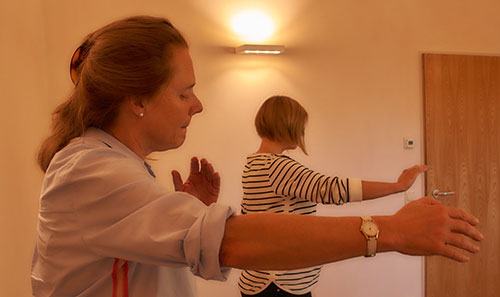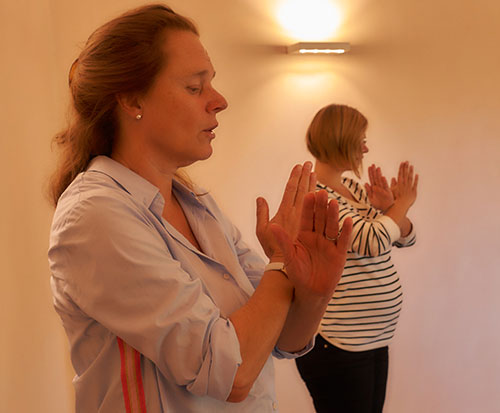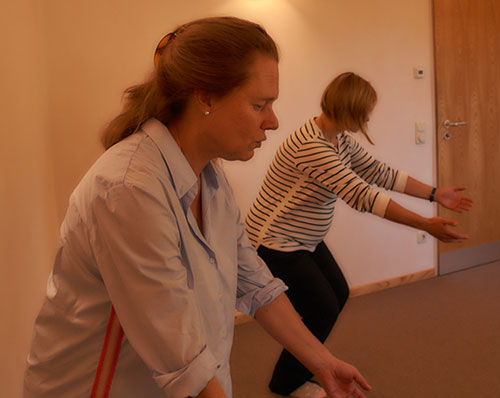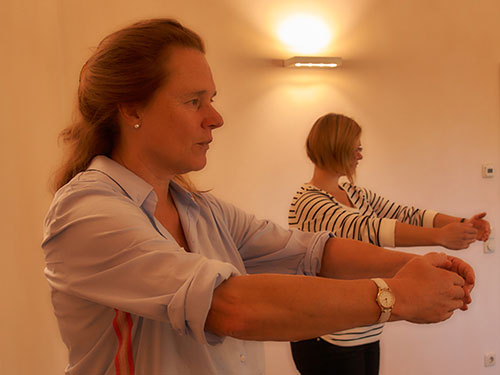Eurythmy Therapy in Pregnancy and Birth Preparation
Mechthild Groh-Schulz
Last update: 06.06.2019
With the conception of a child it is not only the baby who develops, also the expectant mother enters into a process of constant change. These changes can manifest physically and mentally through nausea, increased sense of smell, generally increased sensitivity, and more pictorial feelings and dreams. These changes are also often associated with severe fatigue and exhaustion. The mother gives the baby space in her body, which is possible thanks to the changing interaction of the mother’s body, spirit and soul. The mother needs to find a new balance, e.g., between giving space and experiencing herself. Hyperemesis, metabolic disorders and premature contractions can occur if there is a clear imbalance.
Eurythmy therapy can be an accompanying support when such symptoms are present.
What is eurythmy?
The word ‘eurythmy’ means ‘good rhythm’.
All processes around pregnancy, childbirth and puerperium are particularly connected with rhythmic processes – such as the rhythm of menstruation, the 40 weeks of pregnancy, the rhythm of contractions, the rhythm of breastfeeding. In eurythmy therapy we practice alternating between movement and rest, tension and release, using rhythmic movements. We pay particular attention to the transitions between the two poles. Eurythmy helps to move from active movement to rest. The exercises mentioned below enable the expectant woman to experience calm and better perceive herself and her child. She can develop an awareness for temporal processes, improve her self-perception, and enhance her ability to use non-verbal communication.

Fig. 1: Eurythmy therapy by therapist and pregnant woman. © Mechthild Groh-Schulz
This type of movement therapy is based on the elements of speech and music.
- On the physical level, we can stimulate or calm metabolic processes via movements and rhythms that correspond to physiological processes of different organs. For this purpose, we particularly convert consonants into movements. Vowels, with their warming and balancing effect, can have a stabilizing influence on the woman’s cardiovascular system.
- On the soul level, trust and security can be found through structuring exercises. These help to improve concentration and orientation and to feel more at home in one’s body. The person practices the directions in space (up–down, right–left, inside–outside), and is guided to experience both lightness and heaviness.
- The expectant mother forms an inner connection to her baby through warmth and centering. This connectedness then also helps carry her through the intensified feelings of pregnancy, which need to be accepted without causing her to become unstable (1).
Indications for eurythmy therapy in pregnancy
Hyperemesis gravidarum
In cases of hyperemesis, we can use eurythmy therapy exercises to promote and strengthen the soul’s connection to the body. The exercises stimulate metabolic processes, enabling a deepening of the woman’s respiration and alleviating the nausea. It becomes easier for her to accept her new situation.
- Experience has shown that in pronounced cases it is helpful to do structuring exercises with the feet only when sitting or lying down: The vowels “A – U – E – I”.
- Careful stimulation of metabolic activity is needed, which is achieved through calm walking and by establishing a relationship to gravity:
Hexameter 1:4, a lullaby with 4 or 8 steps, experiencing pauses. - Once the expectant mother’s condition has improved, her arms can be included. Here, too, structuring exercises are indicated:The vowels “O – E” or “A – E”, possibly “B”.

Fig. 2: Eurythmy therapy exercise "E" to experience boundary and structure. © Mechthild Groh-Schulz
Metabolic disorders – meteorism (gas or bloating) and constipation
In cases of special metabolic disorders such as bloating and constipation, the information given in Rudolf Steiner’s eurythmy therapy course applies (2). There he explains that the same approach to treatment for metabolic problems can be used, whether the woman is pregnant or not. The difference lies in the intensity: during pregnancy, such sound movements must be adapted to the state of the pregnancy, i.e., his suggestions for eurythmy therapy can be implemented without jumps and in a “more quiet” way (2, p. 123).
Premature labor
If there is a tendency to premature contractions and/or mental tension, it is helpful to perform opening and flowing movements. The element of water, which can flow and surrender without any tension of its own, offers many images for movement. “M” and “L” can convey the element of water.
The sound “M” is a calmly flowing sound gesture that stimulates exhalation. In his course on education for special needs, Rudolf Steiner explained: “’M’ is that which [...] places the whole organism into exhalation [...]” (3, p. 163).
“M” can be performed with the whole body, with one’s arms, hands, fingers or feet, as well as with an empathetic tilting of the forehead and letting go of the pelvis in the area of the lumbar spine.
These exercises can bring breadth and relaxation into the pelvic girdle.
The sound “L” – well experienced in the image of a wave, in the rhythmic rising and falling of water (a dynamically flowing rounded movement) is effective right into the woman’s fluid organism. The “L” movement brings expansion and consolidation into an interplay.

Fig. 3: Eurythmy therapy exercise "M", a flowing and relaxing gesture. © Mechthild Groh-Schulz
Case report of a patient with preterm labor
Case history: Mrs. K. has had an increased tendency to sustained cramping in the uterus, which often only dissipates after 10–20 minutes. We also observe shallow breathing, cold hands and feet, and a worried mood.
1st session: We start with a lullaby. We practice calm contraction (tightening) and opening (loosening) with our hands. This is done with a “breathing” movement, with the aim of not getting caught in either extreme, taking care not to fixate the contraction, rather to switch directly back from it to the gesture of opening. Ms. K. notices that she is entering the tense posture too quickly and is then letting go without transition after holding the contracted position for a longer time. Her movement snaps from one extreme to the other without entering into a mediating process.
My hint that organ rhythms are much slower – more like deep-sea movements or like a flower that slowly opens in the sunshine and closes again in the evening – helps Mrs. K. to create transitions and to connect her breathing with them over time.
The connection between breathing and contractions is well known in obstetrics and so we also work on rhythmic breathing, with an emphasis on exhalation.
The further course of treatment: We subsequently work with the sound gesture “M”. The arms reproduce the sound “M”, both speech and movement form the “M”. Everyone, no matter what their origin, experiences this speech gesture as one of tasting (mmh...), feeling and touching (mmh...) and with the sense of saying, “I understand”. This speech gesture promotes a quality of listening into and feeling into something. This can be followed by an “ah” (“I have understood”) and with the sense that the self can relate to whatever it is. “M” is always a swinging back and forth, a coming into a relationship.
Final result: Over the course of time Mrs. K.’s breathing deepens and her tendency to cramp decreases. Her uterus becomes softer and can relax more quickly. The quality of sleep also improves during the course of the treatment. Ms. K. appears to be more confident and she reports that she also feels a better connection to her baby.
Eurythmy therapy for birth preparation
Eurythmy therapy exercises to prepare for childbirth have proven successful at the end of pregnancy. These are also taught in courses. These exercises should not be regarded as a mere “technique”. The quality of eurythmy gives a holistic character to the relaxation and breathing exercises that are helpful during birth, which can connect all levels – body, soul and spirit. Overall, the woman develops a better feeling for her body. She is not asked to observe her breathing – it is allowed to flow freely during the exercise. Posture and movement can thus be found individually and with presence of mind.
Weak contractions during childbirth can be prevented by strengthening rhythm – an important prerequisite for a good course of birth for mother and child.
Practical experience has shown that mothers experience such birth preparation also as an aid in interacting with their newborn child. Eurythmic exercises awaken a perception for the shaping of life as a process in time and they sharpen the woman’s awareness of this aspect. The daily rhythm of waking and sleeping, as well as the structure of the year and our experience of weekly rhythms, provide orientation. For small children these breathing rhythms are an especially important support, as at the beginning of life babies have to learn breathing, sleeping, digesting, as well as switching back and forth between being together and being alone.

Fig. 4: Eurythmy therapy exercise for birth preparation. © Mechthild Groh-Schulz
Bibliography
- Groh-Schulz M. Heileurythmie in der Schwangerschaft – Ein Fallbeispiel. Der Merkurstab 2018;71(5):387–392. DOI: https://doi.org/
- Steiner R. Heileurythmie. GA 315. 5th ed. Dornach: Rudolf Steiner Verlag; 2003. English translation: Steiner R. Eurythmy therapy. London: Rudolf Steiner Press; 2009.
- Steiner R. Heilpädagogischer Kurs. GA 317. 8th ed. Dornach: Rudolf Steiner Verlag; 1995. English translation: Steiner R. Education for special needs. The curative education course. London: Rudolf Steiner Press; 2015.